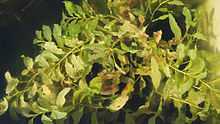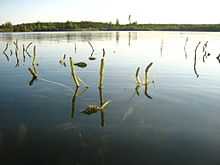Potamogeton lucens
| Potamogeton lucens | |
|---|---|
 | |
| Scientific classification | |
| Kingdom: | Plantae |
| (unranked): | Angiosperms |
| (unranked): | Monocots |
| Order: | Alismatales |
| Family: | Potamogetonaceae |
| Genus: | Potamogeton |
| Species: | P.lucens |
| Binomial name | |
| Potamogeton lucens L.[1] | |
| Synonyms[2] | |
|
Buccaferrea lucida Bubani Potamogeton acuminatus Schumach. Potamogeton americanus Roem. & Schult. Potamogeton angustifolius Bercht. & J.Presl. ex Opiz Potamogeton caudatus Seidl ex Opiz Potamogeton coriaceus (Nolte ex Mert. & W.D.J.Koch) Fryer Potamogeton corniculatus Schur Potamogeton cornutus J.Presl. & C.Presl. Potamogeton dentatus Hagstr. Potamogeton gaudichaudii Cham. & Schltdl. Potamogeton gramineus subsp. zizii (Mert. & W.D.J.Koch) K.Richt. Potamogeton lanceolatus Eichw. Potamogeton lindenbergii Lehm. ex Graebn. Potamogeton longifolius J.Gay ex Poir. Potamogeton lucidus Gueldenst. Potamogeton macrophyllus Wolfg. Potamogeton nitens Willd. ex Cham & Schltdl. Potamogeton proteus Cham & Schltdl. Potamogeton pseudolongifolius Papch. Potamogeton rotundifolius Schultz Potamogeton sinicus Migo Potamogeton teganumensis (Makino) Makino Potamogeton volhynicus Besser ex Roem. & Schult. Potamogeton zizii Mert. & W.D.J.Koch Potamogeton zizii Koch ex Roth Spirillus lucens (L.) Nieuwl. Spirillus zizii (Mert. & W.D.J.Koch) Nieuwl. | |
Potamogeton lucens, or shining pondweed,[1] is an aquatic perennial plant native to Eurasia and North Africa. It grows in relatively deep, still or slow-flowing, calcareous freshwater habitats.
Description
Shining pondweed is a large plant with robust creeping rhizomes and long, terete, branching stems, typically up to 2.5 m but exceptionally to 6 m. The leaves are large, 75–200 mm (exceptionally more) long and 25–65 mm wide, 2-6 times as long as broad;[3] as with the smaller P. gramineus, the leaves on the branches are smaller than those on the main stem. The leaves are pale green or yellowish, translucent, shiny with distinctive netted veining, minutely denticulate margins, and a short petiole of 1–12 mm.[3] Floating leaves are absent.
Flowers appear between June and September.[4] The fruits are 3 mm across.
Like most other broad-leaved pondweeds, Potamogeton lucens is tetraploid, with 2n=52.[5]
Over much of its range, shining pondweed is not likely to be confused with any other species. However, in southern Europe the related and quite similar P. schweinfurthii has recently been discovered.[6][7] P. lucens can usually be distinguished by its relatively broader leaves, 2-6 times as long as they are broad, and most or all of which are petiolate, but some forms are very difficult to distinguish without a detailed comparison of multiple characters.[6]
However, there are hybrids with various other pondweed species including P. gramineus (P. × angustifolius J.Presl.), P. perfoliatus (P. × salicifolius Wolfg.), P. alpinus (P. × nerviger Wolfg.), P. nodosus (P. × subrufus Hagstr.) P. sarmaticus (P. × pseudosarmaticus Papch.), P. crispus (P. × cadburyae Dandy & G.Taylor), P. praelongus (P. × jutlandicus Zalewska-Gał.) and P. natans (P. × fluitans Roth).[3] It hybridises with P. wrightii (P. × inbaensis Kadono)in Japan[8] and China.[9] Some of these hybrids can be quite common, and are not always easy to distinguish from P. lucens.[3]
A triple hybrid, P. gramineus × lucens × perfoliatus (P. × torssandrii (Tiselius) Dörfler), is also known.
Taxonomy
Potamogeton lucens (lucens meaning 'shining') was one of the original species named by Linnaeus in Species Plantarum (1753). Shining pondweed is morphologically quite variable, and as a result has received a bewildering number of synonyms.
DNA analysis[10] indicates that P. lucens is one of the broad-leaved pondweed clade (section Potamogeton) and is probably most closely related to P. gramineus and the North American P. illinoensis.
Distribution
Potamogeton lucens is native to Europe (including Britain, continental Europe, Scandinavia), Asia (Afghanistan, India, Kazakhstan, Kyrgyzstan, Myanmar, Nepal, Pakistan, Philippines, Russia, Tajikistan, Turkmenistan, Uzbekistan), the Middle East and North Africa.[11] In North America it is replaced by the rather similar P. illinoensis.

Biochemistry
A furanolabdane diterpenoid extracted from P. lucens is algicidal.[12]
Dried and ground shining pondweed has been shown to be effective at binding heavy metals, raising the possibility of using biomass from this plant as a means of treating contaminated sediments.[13][14]
Ecology and Conservation
Potamogeton lucens is strictly a lowland plant of standing or slow-flowing calcareous water,[15] especially favouring peatland areas with a calcareous water supply such as the Cambridgeshire Fens.[3] Although having a preference for deep water (0.5-2.0 m),[16] it can persist in shallow areas, and may also grow in open reedbeds, which may provide a refuge in eutrophic waters.[3]
Shining pondweed is more prevalent in older, poorly connected floodplain lakes[16][17] and is a poor colonizer, slow to regenerate following floods[18] and intolerant of drawdown.[16] In Britain shining pondweed is mainly restricted to southern England with scattered outposts in Scotland and Wales, but is more widespread in Ireland.[3] It is tolerant of eutrophication to some extent and in marl lakes it may replace Chara spp. as nutrient levels increase, before itself being ousted by fine-leaved pondweeds and eventually phytoplankton at higher nutrient levels. In a study of nutrient-rich river backwaters in the R. Tizsa (Hungary), shining pondweed was tolerant of very high phosphate concentrations, so long as chemical oxygen demand and chlorophyll-a concentrations in the water were not too high.[19] In the Netherlands, the invasive Elodea nuttallii may compete with it for habitat.[16]
Globally and on the majority of national Red Lists, shining pondweed is not considered threatened.[20] P. lucens has declined somewhat in Britain, but still remains reasonably widespread.[21]
Shining pondweed is one of the so-called Magnopotamion group of pondweeds. These are a characteristic floristic component of the protected Habitats Directive habitat Type 'Natural eutrophic lakes with Magnopotamion'.[22]

Cultivation
Shining pondweed is rarely cultivated, even though it is both easy to grow and an attractive plant. Its distinctive, large, transparent netted leaves are unlike any other commonly cultivated pond plant. In common with other pondweeds of this group it roots poorly from stem cuttings and is best propagated by division of the rhizomes. It is easy to grow in a garden pond or even in a barrel, but unlike some other submerged plants needs to be able to root in a suitable substrate such as sand or aquatic compost. Plants being established should be weighted down initially to allow them to root. Where waterfowl grazing is likely, protection will be necessary, especially in the early summer growth period.[23]

References
- ↑ 1.0 1.1 Potamogeton lucens was first described and published in Species Plantarum 1:126. 1753. GRIN (11 April 2005). "Potamogeton lucens information from NPGS/GRIN". Taxonomy for Plants. National Germplasm Resources Laboratory, Beltsville, Maryland: USDA, ARS, National Genetic Resources Program. Retrieved 23 October 2013.
- ↑ The Plant List: Potamogeton lucens. Royal Botanic Gardens, Kew and Missouri Botanic Gardens. Accessed November 18, 2014
- ↑ 3.0 3.1 3.2 3.3 3.4 3.5 3.6 Preston C.D. (1995) Pondweeds of Great Britain and Ireland. BSBI Handbook No. 8. Botanical Society of the British Isles, London.
- ↑ Rose, Francis (2006). The Wild Flower Key. Frederick Warne & Co. pp. 491–492. ISBN 978-0-7232-5175-0.
- ↑ Kaplan Z., Jarolímová V., Fehrer J, 2013. Revision of chromosome numbers of Potamogetonaceae: a new basis for taxonomic and evolutionary implications. Preslia, 85, 421-482.
- ↑ 6.0 6.1 Kaplan Z. 2005. Potamogeton schweinfurthii A. Benn., a new species for Europe. Preslia - Praha, 77, 419-431.
- ↑ Aymerich P., Kaplan Z., Guardiola M., Petit A., Schwarzer U. 2012. Potamogeton schweinfurthii in the Iberian Peninsula. Anales de Jardín Botánico de Madrid, 69, 187-192
- ↑ Ito, Y., Nr. Tanaka and K. Uehara. 2007. Inferring the origin of Potamogeton × inbaensis (Potamogetonaceae) using nuclear and chloroplast DNA sequences. Journal of Japanese Botany 82: 20-28.
- ↑ Ito, Y. and Nr. Tanaka (2013) Additional Potamogeton hybrids from China: Evidence from a comparison of plastid trnT-trnF and nuclear ITS phylogenies. APG: Acta Phytotaxonomica et Geobotanica 64: 15-28.
- ↑ Lindqvist C., De Laet J., Haynes R.R., Aagesen L., Keener B.R., Albert V.A. 2006. Molecular phylogenetics of an aquatic plant lineage, Potamogetonaceae. Cladistics, 22, 568-588.
- ↑ Guo Y., Haynes R.R., Hellquist C.B., Kaplan Z. 2010. Potamogeton. Flora of China, 23, 108-114. http://www.efloras.org/florataxon.aspx?flora_id=2&taxon_id=10726
- ↑ Waridel P., Wolfender J-L., Lachavanne J-B., Hostettmann K. 2004. ent-Labdane glycosides from the aquatic plant Potamogeton lucens and analytical evaluation of the lipophilic extract constituents of various Potamogeton species. Phytochemistry, 65, 945-954.
- ↑ Schneider I.A.H., Smith R.W., Rubio J. 1999. Effect of mining chemicals on biosorption of Cu(II) by the non-living biomass of the macrophyte Potamogeton lucens. Minerals Engineering, 12, 255-260.
- ↑ Schneider I.A.H., Rubio J. 1999. Sorption of heavy metal ions by the nonliving biomass of freshwater macrophytes. Environmental Science and Technology, 33, 2213-2217.
- ↑ Vestergaard O., Sand-Jensen K. 2000. Alkalinity and trophic state regulate aquatic plant distribution in Danish lakes. Aquatic Botany, 67, 85-107.
- ↑ 16.0 16.1 16.2 16.3 van Geest G.J., Coops H., Roijackers R.M.M., Buijse A.D., Scheffer M. 2005. Succession of aquatic vegetation driven by reduced water-level fluctuations in floodplain lakes. Journal of Applied Ecology, 42, 251-260.
- ↑ Barta V., Schmidt-Mumm U., Janauer G.A. 2009. Adapting floodplain connectivity conditions – a prerequisite for sustaining aquatic macrophyte diversity in the UNESCO Biosphere Reserve Lobau (Austria). Ecohydrology & Hydrobiology, 9, 73-81.
- ↑ Barrat-Segretain M-H., Henry P., Bornette G. 1999. Regeneration and colonization of aquatic plant fragments in relation to the disturbance frequency of their habitats. Archiv für Hydrobiologie, 145, 111-127
- ↑ Lukács B.A., Dévai G., Tóthmérész B. 2009. Aquatic macrophytes as bioindicators of water chemistry in nutrient rich backwaters along the Upper-Tisza river (in Hungary). Phytocoenologia, 39, 287-293.
- ↑ Allen D.J. 2011. Potamogeton lucens. The IUCN Red List of Threatened Species. Version 2014.3. <www.iucnredlist.org>. Downloaded on 03 December 2014.
- ↑ Online Atlas of the British and Irish Flora: Potamogeton lucens.
- ↑ "Joint Nature Conservation Committee: 3150 Natural Eutrophic Lakes". Retrieved 2014-10-19.
- ↑ Lauridsen T.L., Sandsten H., Møller P.H. 2003. The restoration of a shallow lake by introducing Potamogeton spp.: The impact of waterfowl grazing Lakes & Reservoirs: Restoration & Management, 8, 177-187.
| Wikimedia Commons has media related to Potamogeton lucens. |